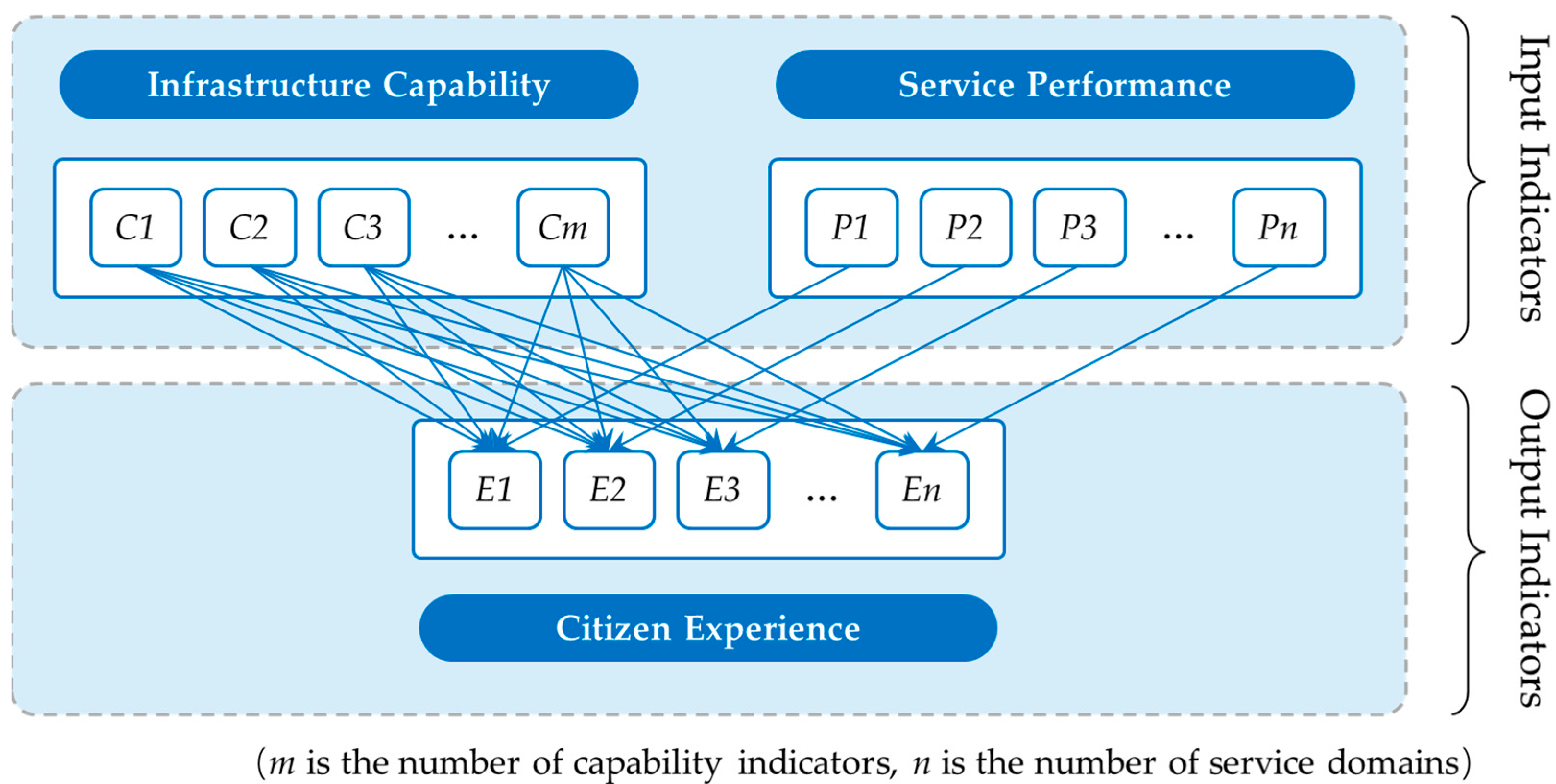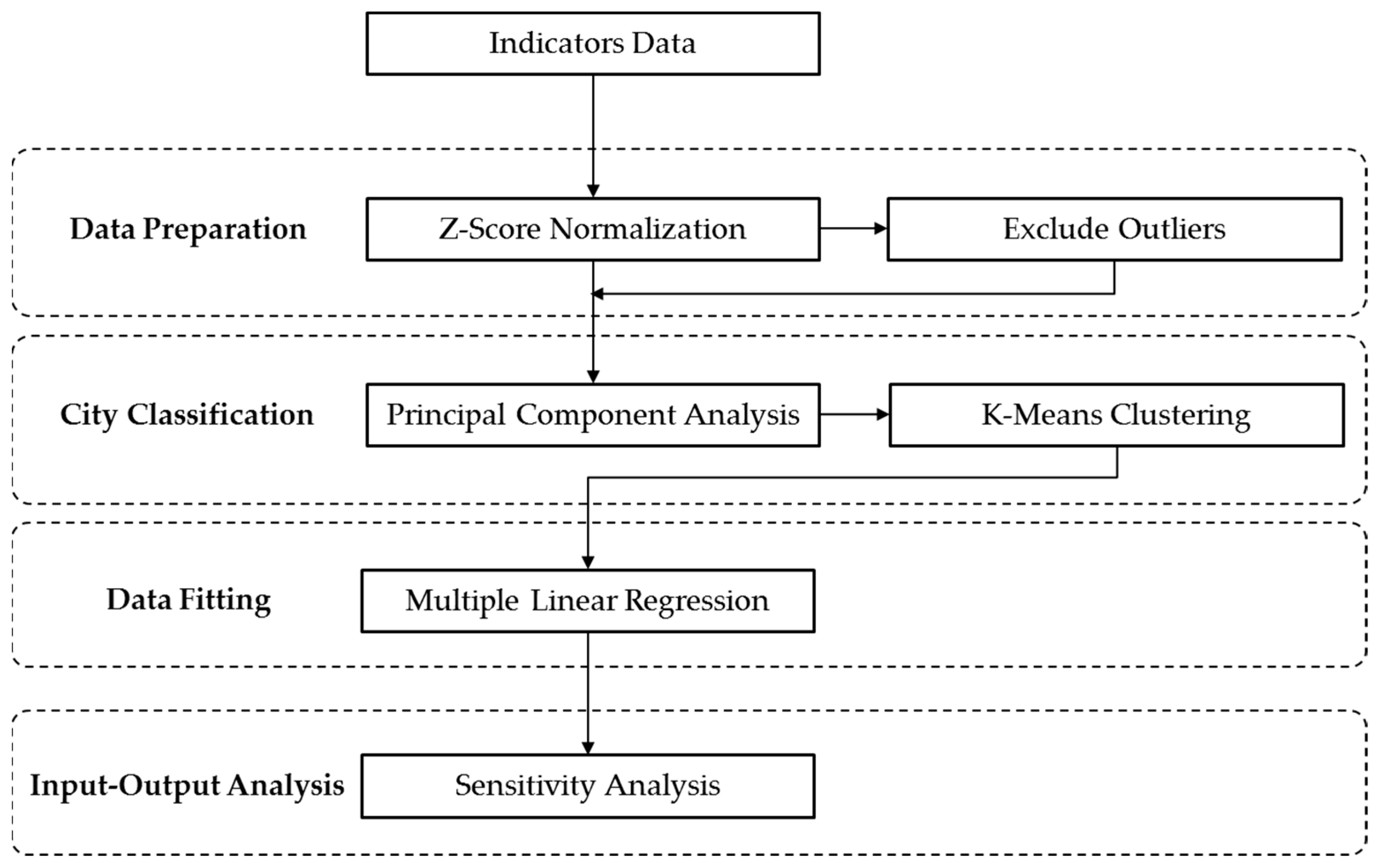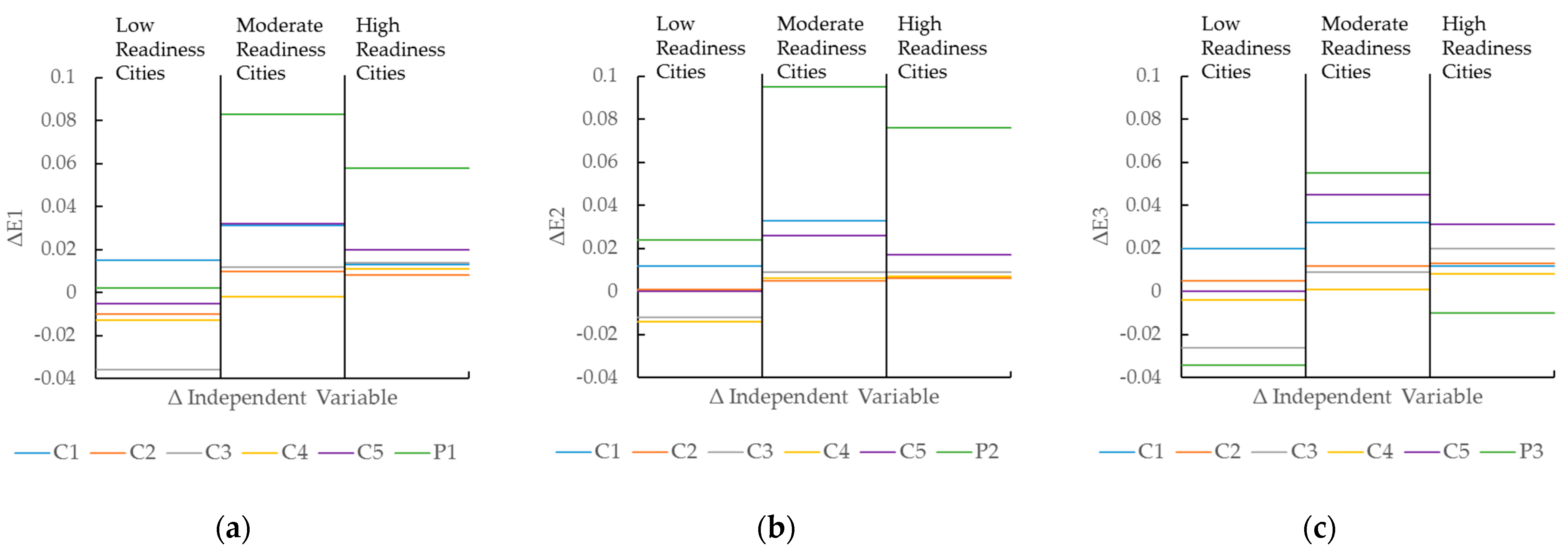1. Introduction
With the development of cloud computing, the Internet of Things, big data, data visualization, distributed computing, and other information technologies, ICT integration has become one of the most important development strategies of cities in the last 20 years. The concepts of wireless city [
1], network city [
2], digital city [
3], intelligent city [
4], smart city [
5], and sentient city [
6] have all been put forward to describe the relationship between ICT and urbanization. These terms mainly reflect the objectives of introducing specific technologies to a city [
7]. Over the past decade, the level of digitization and informatization of urban systems has become higher and higher, and fundamental changes have taken place in citizens’ living environments and cities’ governance modes. The smart city has become a paradigm of city development and sustainable socio-economic growth [
5] and has been widely discussed by governments, industry, and academia all over the world [
8]. With the rapid advancement of urbanization, urban development is also facing great challenges. At present, cities around the world are making a rapid transition to a low-carbon environment, high quality of life, and resource-saving economy. The future of urban development will depend not only on the deployment of hard infrastructure but also on the availability and quality of knowledge communication and social infrastructure [
9]. The smart city has become an effective solution to the complex problems encountered in the process of rapid urbanization [
10].
Evaluation has come to play an increasingly important role in the construction of smart cities [
11]. Identifying the key aspects of smart cities and systematically evaluating their level of development will be of great significance for guiding and promoting the smart development of cities [
11,
12]. With the development of smart city research, academia, governments, and enterprises have proposed multifarious evaluation methods to measure the development level of smart cities. Some standards have specified and established definitions and methodologies for a set of indicators for smart cities. The current smart city evaluation index model has a variety of architectural methods. Some of these methods evaluate the critical factors of smart cities, such as the Rankings of European Medium-Sized Cities [
13,
14], the Cohen Smart City Index [
15,
16], and Sustainable Cities and Communities—Indicators for Smart Cities (ISO 31722:2019) [
17]. Some of them evaluate the infrastructure capabilities pillar and service performance pillar, such as the IMD-SUTD Smart City Index [
18], the Evaluation Indicators for New-Type Smart Cities (GB/T 33356–2016) [
19], and the Information Technology—Smart City ICT Indicators (ISO/IEC 30146:2019) [
20]. The smart city evaluation results play a significant role in the study of smart cities. The performance of smart cities is a very important guide for stakeholders in positioning these cities, triggering more projects to be undertaken [
21], and defining strategies for future development [
22].
Return on investment (ROI) is a performance measure used to evaluate the efficiency of an investment in a particular case. It measures the amount of return made on an investment relative to the cost [
23]. In smart cities, ROI is becoming a key consideration in terms of the Internet of Things [
24,
25,
26], data centers [
27], smart homes [
25], smart grids [
28,
29], data security [
30], and other technologies. Investment in public services is generally shrinking due to the deteriorating global economic situation, leading to services with both social utility and a clear return on investment being given priority [
31,
32]. A major concern is that while many smart city solutions are expensive to procure and service, it is not clear what their return on investment will be [
33,
34]. However, there is a lack of appropriate, systematic, and proven methodologies or metrics for reporting and verifying the return on investment for the design of smart cities [
31,
35,
36]. To better prioritize investment, maximizing return on investment should be seen as a standard objective of smart cities [
9].
A smart city is a long-term evolution system, which cannot be studied statically and in isolation. In the existing smart city evaluation research, many methods divide a smart city into several dimensions according to the key factors. This can guide the construction of smart city conceptually. However, without the support of quantitative analysis, it will be difficult to guide the actual decision-making process in smart cities. Since people’s participation, ideas, and perspectives are critical factors for smart cities [
37], the concept of Quality of Experience (QoE) is rapidly gaining attention in smart cities [
38]. This means that for user-centered public services in smart cities, it is necessary to not only ensure a high Quality of Service (QoS) but also provide a satisfactory Quality of Experience (QoE). The evaluation, analysis, and improvement of QoE in smart cities are challenging research problems.
The aim of this paper is to analyze the effectiveness of smart cities through evaluation, and provide reference and guidance for rational decision making of smart city construction. Inspired by the aforementioned smart city evaluation models, we focus our study on learning how smart city infrastructure capability and service performance affect citizen experience. The model and analysis methods proposed in this paper can not only avoid the limitations of previous studies, but also provide targeted promotion strategies to smart cities based on their own development stage, to achieve more accurate and efficient improvement. The rest of this paper is organized as follows. In
Section 2, the current research on QoE in smart cities and smart city evaluation models are reviewed.
Section 3 explains the design of research methods.
Section 4 presents the results of data analysis.
Section 5 discusses the results, and
Section 6 concludes the paper.
5. Discussion
Smart city evaluation is an important form of guidance in the construction of smart city. Academia, governments, and enterprises have proposed different evaluation methods to measure the level of development of smart cities [
72]. Most methods focus on how to measure the level of development of a smart city. However, since maximizing the return on investment (ROI) has become a standard objective of smart cities [
9], knowing the overall score or ranking of smartness is not enough to guide the decision making. Measuring the efficiency of smart city construction is a basic and long-term work for urban sustainable development [
12]. This study attempts to explore how to effectively improve the smart city, that is, to allocate investment reasonably and achieve the best results possible with limited resources.
The literature review of this study highlighted the significance of return on investment [
23,
31,
32] and citizen engagement [
21,
37] in smart cities. We not only summarized the common features of smart city evaluation methods from the related literature, but also found research gaps from previous research. The common shortcomings include the lack of citizen engagement, ignoring the efficiency of construction, inadequate number of evaluation samples, insufficient quantitative analysis, overlooking of interlinkages, and lack of tailored guidance.
In order to solve the shortcomings mentioned, this study provides a solution for smart city evaluation and data analysis. The proposed model can be extended as needed to measure the service areas not mentioned in this study, or to apply in other countries or regions. The uniqueness of our evaluation framework includes: (1) its classification of cities according to their features; (2) focusing on citizens’ experience with smart city services; and (3) improving construction efficiency of smart cities by studying the relationship between input factors and output factors. The obvious breakthrough of this study is verifying the feasibility of the proposed method by real data.
However, the main limitation of this study is the high dependence on data availability. The effectiveness of the proposed method has been verified in only three service domains, of which the evaluation data is complete. Although the method is generally applicable and elastic, the analysis results of these three service domains cannot guide the construction of other service domains. Since each city has different conditions and characteristics, the specific findings in China may be different from those in other countries. At present, we have made the utmost effort to include as many cities and service domains as possible. In addition, the model proposed in this paper is a simplification of the real smart city. If there are enough credible data, more influencing factors can be added to the model to simulate urban development more accurately.
To overcome these limitations, further research in this area should focus on three directions. Firstly, it is necessary to explore the relationship between input and output factors in more service domains. Secondly, the economic and social attributes can be involved in the CPE model. The preliminary consideration of it is to improve the model into a neural network with hidden layers. Thirdly, when the evaluation data is accumulated for some time, the changes in development strategies after the improvement of urban readiness can be dynamically analyzed. These will be explored, enriched, and improved in further research.
6. Conclusions
This paper proposes a correlation analysis method for input and output indicators of smart cities. From the analysis of literature on smart city evaluation, some typical input and output factors of smart cities are extracted. An extensible index system is established to evaluate the infrastructure capability, service performance, and citizen experience of smart cities. On this basis, principle component analysis and k-means clustering are applied to classify cities according to their readiness level of infrastructure. Multiple linear regression is applied to investigate the internal relationship between input indicators and output indicators in different types of cities. Then we analyze the impact of the change of each input indicator on each output indicator by sensitivity analysis.
The proposed evaluation method provides an effective basis for the scientific measurement of input and output factors of smart cities. It assists cities to assess the effect of existing smart services and more efficiently generating distribution schemes for the improvement of infrastructure capability and service performance. The findings contribute to accurately designing or adjusting strategies for different types of smart cities. Our method can guide city governments to formulate specific measures to improve the construction effectiveness of smart cities, which will also have a significant reference for the analysis of investment benefits under limited cost.
Through the empirical study involving 275 cities and 1,073,500 citizens in China, we draw some policy implications for smart city construction.
6.1. Considering Urban Characteristics in Policy Making
Since cities have huge differences in their basic conditions and planning directions, it is not suitable to adopt a one-size-fits-all development strategy for smart cities. Each city should focus on its own situation and actual demand when making development decisions. Policy makers should decide how to improve the smartness of the city according to its current stages of development, to achieve accurate and efficient improvement.
For example, in order to maximize the government service experience with limited investment, a developed city with mature ICT infrastructure and good organization may emphasize the improvement of service capacity, such as providing more diversified and convenient services. On the other hand, less developed cities should give priority to improving ICT infrastructure and organization and management, to ensure basic network transmission and process optimization.
According to our research, it is necessary for cities to find the correct positioning according to their own basic characteristics. The characteristics here include the readiness of facilities, data, and management analyzed in this paper. In addition, it can also include attributes such as population, GDP level, major industries, and so on.
6.2. Maximizing the Effectiveness of Investment
A truly efficient smart city needs to operate in an integrated manner in order to better prioritize investment and maximize the value of the return. In general, investment should be given priority to infrastructure, followed by organization and management, then to data and applications.
For example, for cities with underdeveloped infrastructures, investing in data sharing and data opening will not produce the desired benefits. If the decision makers unwisely choose to improve data sharing and data opening without paying attention to the construction of network facilities or IoT, the investment will be wasted and citizens’ experience will not be improved. Meanwhile, if the infrastructure and management of a city have been improved to a certain level, the beneficial effect gained by improving them will decrease. Decision makers should adjust their strategies in time to make data opening and data sharing their priority.
Cities need to comprehensively evaluate the possible effects of investment strategy, and decide the investment roadmap rationally. Especially for cities with limited budgets, priority should be given to the domains with the highest expected input-output ratio.
6.3. Emphasizing the Value of Citizens’ Perceptions
The smart city is the product of the high integration of socio-economic development and information technology. It should be emphasized that the performance at the technical level does not directly reflect the user’s satisfaction. In technology-driven smart city projects, citizens often passively accept top-down services rather than the bottom-up expression of opinions.
As citizens are the most critical users of smart cities, high citizen satisfaction should be one of the most important goals of smart cities. Citizens’ perceptions should be fully considered not only when measuring the effectiveness of smart city construction, but also before, during, and after smart city construction.
City governments can strengthen the requirement analysis through questionnaires or other methods during the designing period of smart city projects. After the smart city projects are put into application, a post-evaluation mechanism can support the sustainable improvement of the projects.















